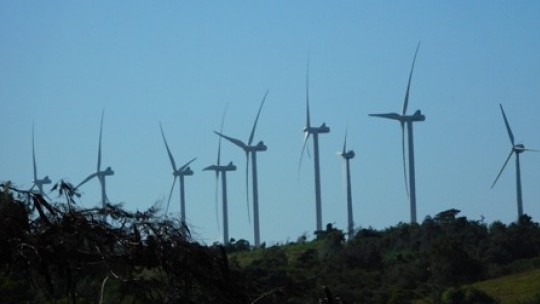Time to set higher targets for renewable energy
10:10 am, Fri January 27, 2017
By Dashan Hendricks
With Liquefied Natural Gas (LNG) from the United States, Jamaica is now on the path towards an energy revolution which, if managed properly, could change the fortunes of the country.
Jamaica had set its heart on getting LNG for a long time. There were disappointments in trying to get the fuel from Trinidad & Tobago. Other efforts to get LNG from other sources failed, but the county was lucky to be on the forefront of the export of the fuel from the U.S.
LNG will certainly help to bring stability in the price of electricity each month. That however is some time away. What must be recognised is that these shipments of LNG are to supply a 120 megawatt power plant at Bogue in Montego Bay, plant which is significant in the country's energy production, but not significant enough for it to have a wide-scale impact on energy prices in the early stages. The full impact on energy prices from the introduction of LNG in the fuel mix to generate electricity in Jamaica will not be felt until the larger 190 megawatt plant in Old Harbour, St Catherine, comes on stream in 2018. When that materialises, Jamaicans will see energy prices which are more stable than they are now.
It has been touted that prices will be lower as well. How much lower will the prices be in 2018, is still left to be seen. What must be understood is that the much touted aim of reducing energy prices by at least 30 per cent in 2018 was set from the base price of US$0.42 per kilowatt hour for electricity in 2012. That would now mean bringing prices to US$0.29 per kilowatt hour.
The Ministry of Energy in the preceding administration said prices could fall 50 per cent below the 2012 level when renewables, chiefly wind and solar, are introduced in the mix. That's 21cents per kilowatt hour! Those prices were achieved earlier this year when oil prices, which form the base of electricity generation in Jamaica, fell below US$30 a barrel in February. Large commercial customers were getting electricity for 16 cents to 18 cents per kilowatt hour.
Renewable
But more than LNG, the next push in price stability for energy must come from a focus on renewable energy. The Jamaican Government has outlined a policy to achieve 30 per cent of the country's electricity being generated from renewables by 2030. Progress towards that target in Jamaica, compared with the rest of the world, however, has been rather slow. Take for example, in 2004 six per cent of Jamaica's electricity was generated from renewable sources. In 2012, that portion amounted to eight per cent. Since then, the country has approved several requests for proposals to generate electricity from renewable sources, pushing the total output over 10 per cent at the end of 2015.
Compare that with the progress being made worldwide and a different picture emerges. In the decade up to 2014, the global trend in renewable energy shows a 53-fold increase in solar photo voltaic capacity, a 15 fold increase in biodiesel production, a 10 fold increase in concentrated solar thermal power (CSP) capacity and a 10 fold increase in wind capacity. The global growth in renewable energy production has been so spectacular that the International Energy Agency (IEA), the World Bank and others in looking back, have reported that renewable energy production targets set for 2020 were met and exceeded by 2010.
Jamaica needs to up the ante and be even more aggressive in its renewable energy target. Setting a target of getting 30 per cent of electricity generated from renewable sources by 2030 shows a lack of ambition and seriousness about energy security. For too long, the country has been at held to ransom by fossil fuel producers, mainly oil. Switching from oil to gas will bring price stability.
The United States is a great friend of Jamaica, but the LNG arrangement still means Jamaica will be depending on imports for its energy future. Targeting renewables and implementing them brings greater energy security. For the most part, renewables are cheaper than conventional sources such as oil, gas and coal. A boost in production of those fuel sources has made them cheap enough to cause some to think investing in renewables right now is not prudent. For the future, it is.
That means Jamaica must doggedly pursue renewable energy solutions. That must be done in a comprehensive way. For example, it must not only be a stated policy, but like the American state of California, which has legislated a renewable energy target, the Jamaican authorities must show they are serious about securing the country's energy future. It means the target for renewables must be more aggressive. Pushing the target to having 50 percent of electricity generated from renewables by 2030 must be a stated aim. Jamaica's energy market is small compared to California, so it is much easier to do.
Policy
A more secure energy future must not stop at generating more electricity from renewable sources. It must include an energy policy which looks at the creation of micro and smart grids. A greater push can be made towards establishing net zero energy buildings for new building construction. These require bold steps and a bold push.
I was heartened recently when the young Senator Matthew Samuda brought a motion to the Upper House to ban plastic bags and styrofoam boxes and cups. That motion is still in Parliament, but it has drawn the response from the country's largest producer of styrofoam to include enzymes in the product to cause it to break down within five years. Maybe a similar push in renewables will bring a similar response. The utility is a willing partner in the renewable space. Let's test the water with a bolder energy target for renewables for Jamaica's energy security.
Dashan Hendricks is RJR’s Group Business Editor

9:32 am, Sat April 20, 2024

8:34 pm, Sat April 20, 2024
.jpg)
11:29 am, Fri April 19, 2024








 All feeds
All feeds







